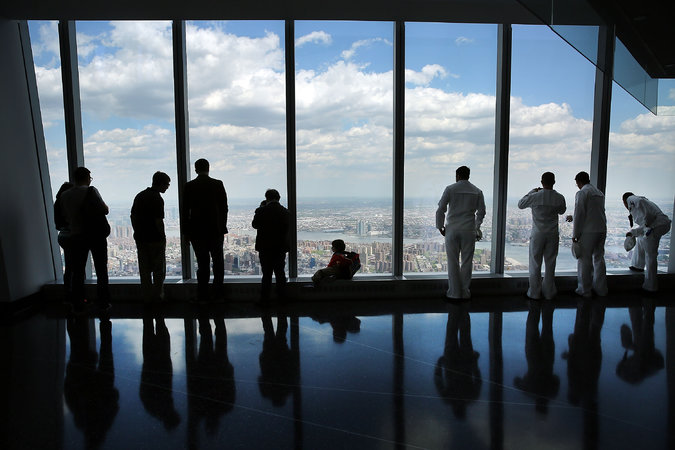Francis X. Clines New York Times
Closure is a clumsy description for the aftermath of 9/11. But there’s a certain sense of completion at ground zero now that the new skyscraper replacing the fallen towers is open to the flow of tourists. They look out, far out, from the observatory that tops 1 World Trade Center and offers 360-degree views of a recovered city and suburbs.
“See Forever” is the upbeat motto of this new perch. It starts 100 stories above the earth, where, far down, there are fewer scars from 9/11 to be seen.
The children happily taking selfies were not alive when the twin towers were brought down by terrorists. The awful past recedes fast to the splendid horizon. You have to stand tight against a window and look straight down to spot the memorial pools that outline the fallen towers’ footprints. They are matte gray reference points for the parent trying to catch a youngster up on distant history.
This focus on the future is understandable. But it is also the reason dozens of New York firefighters anxiously packed a congressional hearing last month as witnesses to the very real scars that remain for thousands of 9/11 first responders and volunteers. These were the people who were eventually struck by long-term illnesses from weeks and months of labor in the pile of destruction, including more than 3,200 who are now cancer patients.
Five years ago, federal programs to provide health care and compensation for these workers and volunteers barely passed Congress in a partisan fracas. It was a national embarrassment after all the bumper stickers and election speeches about never forgetting. The programs have since helped more than 33,000 responders and survivors with medical conditions and tens of thousands of others who must still be monitored for the aftereffects from the attacks in Manhattan, at the Pentagon and in Shanksville, Pa. More than 5,600 victims or their survivors have received compensation running beyond $1.3 billion.
The aid should have been designed as permanent programs, like those for black lung and the diseases of nuclear plant workers. But a thin compromise set only a five-year term. Now the fight must begin anew, for the programs start phasing out this October and final action is needed before next year’s elections. The firefighters who went to push for continuation of the programs last month may have been surprised to discover that Republican members who rigidly opposed the health and compensation programs in 2010 had to admit the track record of the programs was impressive.
They were struck by how far so many Americans traveled to help after 9/11. The 71,942 people monitored and helped last year came to New York from 429 of the 435 congressional districts. “There are 75 Michigan residents currently enrolled,” noted Representative Fred Upton, Republican of Michigan, who was a skeptic the first time around. This time, he praised the program. “The bill needs to be passed,” he said flatly, as the scars of 9/11 returned to the congressional agenda.
A version of this editorial appears in print on July 20, 2015, on page A18 of the New York edition with the headline: A View of the Recovered City, and Yet


